|
|
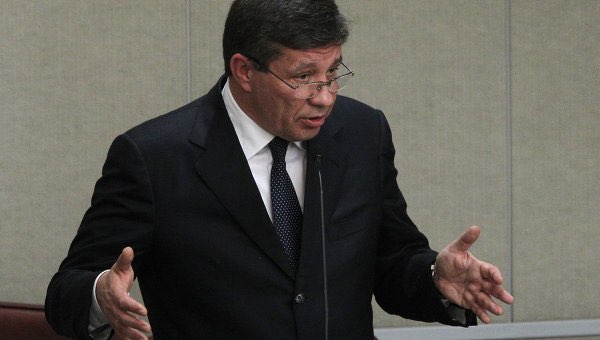 Vladimir Popovkin addressing the Russian parliament in October 2011. (credit: RIA Novosti) |
The status of Russia’s human spaceflight program (part 2)
by Bart Hendrickx
Monday, February 27, 2017

[Editor’s Note: Part 1 was published last week.]
Aiming for the Moon
After the Soviet Union failed to beat America in the race to the Moon in the late 1960s, plans for piloted missions to the Moon and Mars receded into the background as the country set its sights on Earth-orbiting space stations. The ever-increasing duration of flights aboard those stations, topped by the 14-month mission of doctor Valeri Polyakov aboard Mir in 1994–1995, did reflect a continued interest in human deep space missions as a long-range goal. By the end of the 1980s, the country even possessed a heavy-lift launch vehicle (Energia) that offered the potential of eventually turning those dreams into reality. However, the collapse of the Soviet Union plunged Russia into a deep economic crisis in which it had to rely on its former Cold War adversary to maintain even a basic human spaceflight program in Earth orbit.
| Whether this turnaround came at Popovkin’s own initiative or was ordered from above is open to speculation, but the more pragmatic approach to spaceflight did receive backing from the Kremlin and was reflected in a long-range strategy for the Russian space program until 2030. |
As Russia’s economy revived after the turn of the century, so did hopes of sending cosmonauts beyond Earth orbit in the near future. By 2009, ambitious plans were circulating for bypassing the Moon and going straight to Mars as early as the 2020s, but those dreams were short-lived. Not long after the Obama Administration redirected NASA’s human spaceflight plans from the Moon to the asteroids and Mars, Russia did exactly the opposite.
In a seminal speech before the Russian parliament on October 7, 2011, the Russian space agency’s newly appointed chief, Vladimir Popovkin, announced a major change of direction in the Russian space program. The primary focus should now be on practical applications of spaceflight (remote sensing, navigation, meteorology, communications), with science coming in second place and piloted spaceflight relegated to third place. He added that the Moon should take center stage in the human program, leaving flights to the asteroids and Mars as objectives for the distant future. Whether this turnaround came at Popovkin’s own initiative or was ordered from above is open to speculation, but the more pragmatic approach to spaceflight did receive backing from the Kremlin and was reflected in a long-range strategy for the Russian space program until 2030, approved by President Vladimir Putin in April 2013.
Writing in an editorial for the newspaper Rossiyskaya gazeta on April 11, 2014, Deputy Prime Minister Dmitriy Rogozin elaborated on the new priorities for the Russian space program. Aptly called “From Cosmic Romanticism to Terrestrial Pragmatism,” the editorial underlined the need to optimize the space program in the interests of the economy, but at the same time also professed more lofty goals. Rogozin said that studies conducted in 2009–2013 had left no doubt that the Moon should be the next goal for Russia’s piloted space program, emphasizing that Russia should go there to stay and not just consider the Moon a stepping stone to Mars. The main objectives of the lunar program would be science, resource utilization, and testing of new technologies. The first Russian human lunar landing mission would take place in 2030, to be followed by the gradual establishment of bases scattered across the lunar surface, a process Rogozin likened to “the conquest of a new continent.”
He also called for the development of a new heavy-lift launch vehicle as well as standardized transportation and habitation systems that could also be used for future exploration of the asteroids and Mars. Even though the strategy approved in 2013 had called for international cooperation in human deep space exploration, Rogozin was now striking a different tone. Responding to an announcement made by NASA several days earlier that it would suspend the majority of its engagements with the Russian Federation as a result of the ongoing situation in Ukraine, he noted that Russia would rely on its vast experience in piloted spaceflight to carve out a strategy independently from “unreliable international partners.”
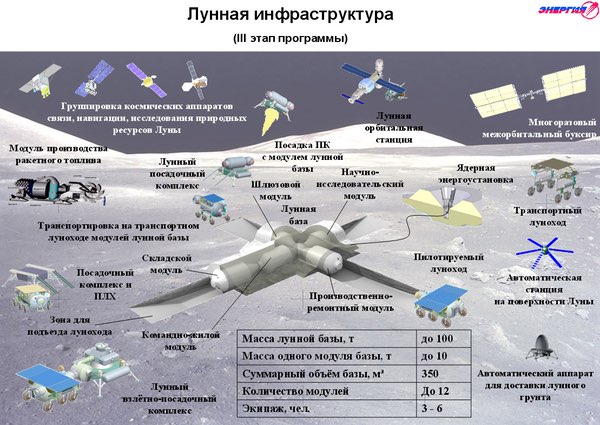 Russian lunar surface and orbital infrastructure as envisaged by RKK Energia. (credit: RKK Energia) |
Having received its new marching orders, the Russian space agency set to work. Leading space companies and institutes of the Academy of Sciences were invited to hammer out the details of Russia’s new lunar program. Some teams focused on the short-term tasks that could be included in the Russian Federal Space Program for 2016–2025 (FSP 2016–2025), others on goals to be accomplished in the 2026–2030 timeframe (“Concept for a National Program of Lunar Exploration”), while still others charted a course for the human exploration of the solar system until the middle of the century (“Long-Range Program for the Exploration of Deep Space”).
The preparatory work took place behind closed doors and only scattered details leaked out in the Russian press over the following months. It was obvious that actual piloted lunar missions were beyond the scope of FSP 2016–2025. Instead, Russia would pave the way to that goal by sending a new series of robotic probes to the Moon (a program suspended after the flight of Luna-24 in 1976) and carrying out the first Earth orbital test flights of a next-generation crewed spacecraft to succeed Soyuz. Development of the new vehicle had begun several years earlier, but it had been reoriented from Earth-orbital to lunar objectives. Also to be included in the FSP 2016–2025 was early research work on a heavy-lift launch vehicle.
| Planning difficulties aside, the inception of the lunar program couldn’t have come at a worse time. |
The plans envisaged a variety of operations in lunar orbit in the 2020s (involving both the Soyuz successor and a lunar orbital station) that were to be coordinated with landings of automatic probes. Human landings would begin after 2030 and lead to the establishment of a periodically-visited outpost in the Moon’s south polar region. The establishment of a large lunar base that could be occupied for longer periods of time would have to wait until the 2040s, with piloted missions to Mars projected for no earlier than the 2050s. The project required the availability of a heavy-lift rocket with a payload capacity of 80–90 tons by the late 2020s and an even heavier rocket with a capacity of 160–200 tons by the late 2030s. The cost was estimated at 12.5 trillion rubles (around $217 billion) between 2015 and 2050.
Critics complained that it was not a strategy for lunar exploration, but a poorly coordinated patchwork of proposals by different space enterprises, in which neighboring chapters often contradicted one another. They also argued that by stretching out the program over so many decades it would become vulnerable to political and financial crises. For exactly the same reasons the newly proposed lunar program soon came under fire from the Military Industrial Commission, a Soviet-era body reinstated in the late 1990s to supervise the country’s vast military industrial complex, of which the space industry is still considered part and parcel.
Planning difficulties aside, the inception of the lunar program couldn’t have come at a worse time. Plummeting oil prices were causing a major slump in the Russian economy and the country was beginning to feel the effects of the sanctions imposed by the West earlier in the year. Heavily relying on the import of Western electronic components, the space industry was far from immune to the sanctions. Not surprisingly, by the end of 2014, Dmitri Rogozin’s enthusiasm for Russia’s colonization of the Moon had significantly cooled. Speaking in a television interview in late December, he said, “Roscosmos specialists are telling us that we should conquer the Moon. I used to like that idea myself, but now we have to count how much money that will cost. What are our real objectives on the Moon, what kind of resources are there on the Moon? We don’t have much money now and we’re surrounded by enemies.”
On top of all this, the Russian space sector was still reeling from a string of embarrassing failures. The most visible of those, the spectacular crash of a Proton rocket shortly after lift-off in July 2013, had sparked off a major reorganization of the Russian space industry. The country’s space companies were consolidated under state control by transferring them from the Russian space agency to a government entity called the United Rocket and Space Corporation (ORKK), founded in March 2014 under the leadership of former auto industry executive Igor Komarov. The Russian space agency itself, headed at the time by Oleg Ostapenko, would continue to act as a federal government body and contracting authority for programs to be implemented by the industry.
The two organizations soon found themselves fighting for control over various responsibilities, leaving the Russian government no choice but to order yet another reorganization in January 2015. It was decided to merge ORKK and the Russian Federal Space Agency into the Roscosmos State Corporation, which officially came into existence on January 1, 2016. By the same January 2015 order, Komarov replaced Ostapenko as head of the Federal Space Agency and would also go on to head the newly formed state corporation. Komarov soon invited Yuri Koptev, the man who had guided the nascent Russian space agency through the turbulent 1990s, to occupy a leading management position at Roscosmos, probably to compensate for his own lack of experience in the space sector.
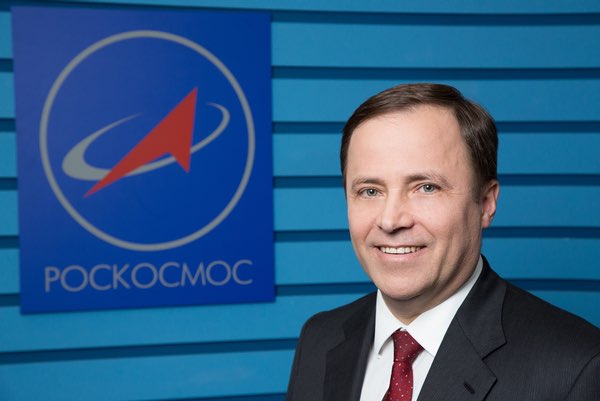 Igor Komarov. (credit: Roscosmos) |
Barely two weeks after assuming his new post, Komarov set up a working group that was to take a fresh look at the country’s human spaceflight plans in light of the deteriorating economic situation. Meeting to discuss the results of that re-evalution on February 23, 2015, the agency’s Scientific and Technical Council decided to extend the country’s involvement in the ISS until 2024, keeping open the option of establishing a Russian space station afterwards with detached elements of the Russian segment. Surprisingly, the goal of sending cosmonauts to the lunar surface in 2030 remained unchanged. It was clear though it was going to have to be accomplished with much less money.
Over the following months the agency struggled to bring an earlier proposed version of the FSP 2016–2025 in line with budget cuts demanded by the Ministry of Finance. It took two meetings with Putin in November 2015 to arrive at a compromise on a budget ceiling for the FSP. When summing up the priorities of the FSP prior to one of the meetings, Putin did not even mention the lunar program and only singled out practical applications and scientific benefits of spaceflight, Russia’s place in the commercial launch market, and the expansion of the ISS Russian segment. Originally due for approval in 2015, the final version of the FSP was finally submitted to the government on February 24, 2016, and passed on March 17, 2016.
| All that is left in the FSP 2016–2025 related to the lunar program is funding (albeit at much reduced levels) for a series of unmanned lunar probes, the next-generation piloted vehicle, and heavy-lift rockets. |
Despite the fact that the FSP covers only civilian space projects, the full version of the document is classified, leaving outsiders with nothing more to go on than a brief summary on the Roscosmos website and snippets of information published in the Russian press. What is known is that the agency’s ten-year budget was slashed from 2.117 trillion rubles (then around $64 billion) in the original September 2014 draft to 1.406 trillion rubles (roughly $21.3 billion) in the final version. The human program was one of the biggest victims of the cuts, seeing its budget reduced from 402.9 billion rubles ($12 billion) to 329.7 billion rubles ($4.9 billion)—the conversion to dollars taking into account the fact that the ruble lost about half its value in less than two years. Moreover, the ten-year budget is not carved in stone and is subject to further revisions in later years.
All that is left in the FSP 2016–2025 related to the lunar program is funding (albeit at much reduced levels) for a series of unmanned lunar probes, the next-generation piloted vehicle, and heavy-lift rockets. Other items, such as early development work on a Moon-orbiting space station, lunar landers, lunar bases, lunar spacesuits, and lunar space tugs, were completely eliminated from government funding in the next ten years. Although 2030 remained the official target date for Russia’s first human lunar landing, Roscosmos officials conceded to the Izvestia newspaper last year that the only way to meet that deadline is for Russia’s space companies (notably RKK Energia) to pay for much of the development work out of their own pockets. Despite the budget cuts, the inclusion of a manned lunar objective in the FSP 2016–2025 is still significant in that it can be considered the first government-level endorsement of a human lunar program since the cancellation of the N-1/L-3 project in the 1970s.
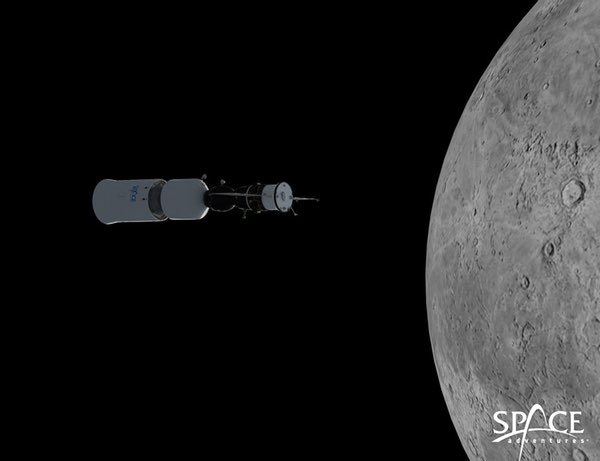 Soyuz heads for the Moon attached to a habitation module and Block-DM upper stage. (credit: Space Adventures) |
Russia’s Orion
The first step on the road to the Moon is the development of a more capable successor to the Soyuz spacecraft that can carry cosmonauts to lunar orbit and back to Earth. That doesn’t mean Soyuz is about to be retired. Having recently celebrated the 50th anniversary of its first mission, Soyuz is likely to remain operational well into the next decade to ferry cosmonauts to ISS and possibly to the follow-on Russian space station. As soon as the US commercial crew vehicles enter service, the annual flight rate will drop from four to two, unless the Russians decide to fly dedicated tourist missions to the ISS. In a recent interview, RKK Energia head Vladimir Solntsev disclosed that his company is prepared to sign an agreement with an unidentified firm as early as this March to arrange seats for nine tourist missions to ISS until 2021. He indicated the deal might be signed with company other than Space Adventures, the US-based firm that has brokered earlier commercial rides to ISS.
The latest modification of the spacecraft, called Soyuz MS, performed its first mission last year and further upgrades are planned for the future. One of those, expected to be introduced in 2021, will allow the vehicle to stay docked to ISS for 370 days, about double the lifetime of the current vehicles. RKK Energia is also eyeing an uncrewed cargo version of Soyuz with the same on-orbit lifetime. The vehicle could return 500 kilograms of materials back to Earth, about ten times more than a Soyuz with three crewmembers on board. It is intended to fly to the new Russian space station that may follow after ISS.
| While Soyuz may satisfy the needs of lunar tourists, it falls well short of the requirements for Russia’s new human lunar program. |
Soyuz itself could be relatively easily adapted for lunar missions. In fact, it was originally conceived in the 1960s as a universal ship for flights in Earth orbit and to the Moon. A stripped-down version of Soyuz called L-1 made several unmanned circumlunar missions in 1968–1970 under the cover name Zond. A beefed-up Soyuz, named “Lunar Orbital Ship” (LOK), was supposed to fulfill the same role as Apollo’s Command and Service Module in human lunar landing expeditions, but the only flightworthy version ever built was lost in the final N-1 launch failure in November 1972.
The idea to fly Soyuz to the Moon resurfaced in 2011, when RKK Energia and Space Adventures announced plans to fly tourists on circumlunar missions. The idea was for a modified Soyuz vehicle dock in Earth orbit with a Block-DM propulsion stage and habitation module launched by a Proton rocket to send a professional Russian cosmonaut and two paying passengers on a one-week trip around the Moon. Nothing much was heard of these plans in the following years until Vladimir Solntsev told journalists last August that RKK Energia has finished a preliminary design for such a Soyuz variant. This would be outfitted with upgraded communication and navigation systems, as well as a strengthened heat shield to withstand the higher temperatures experienced during high-speed re-entries from the Moon. Considering the short duration of the mission, radiation shielding would not be required, he said.
Solntsev pointed out that RKK Energia is ready to start “large-scale work” on this project as soon as Space Adventures has attracted enough customers, adding that eight people have expressed serious interest so far, including a Japanese family. Film director James Cameron was one of the first to make a reservation for a lunar mission back in 2011, but it is not clear if he is among the eight still interested now. Space Adventures officials interviewed by the Izvestia newspaper said that the price for a Moon ticket has been lowered from the initial $150 million to $120 million, but they admitted that the market for such flights is likely to remain small. Solntsev said in an interview last week that the first mission can be flown five to six years after a contract is signed, meaning it will certainly not take place before the end of the decade.
While Soyuz may satisfy the needs of lunar tourists, it falls well short of the requirements for Russia’s new human lunar program. The Russian space agency has been aiming to develop a successor to Soyuz for more than a decade. Formal government approval for a next-generation manned vehicle came in October 2005 with the adoption of the Federal Space Program for 2006–2015. With no lunar objective in mind yet, requirements were for the vehicle to be at least 80 percent reusable, fly no less than 20 missions, and carry up to six people. The leading contender was RKK Energia’s Kliper (“Clipper”) spacecraft, which could be built either as a lifting body or a winged ship.
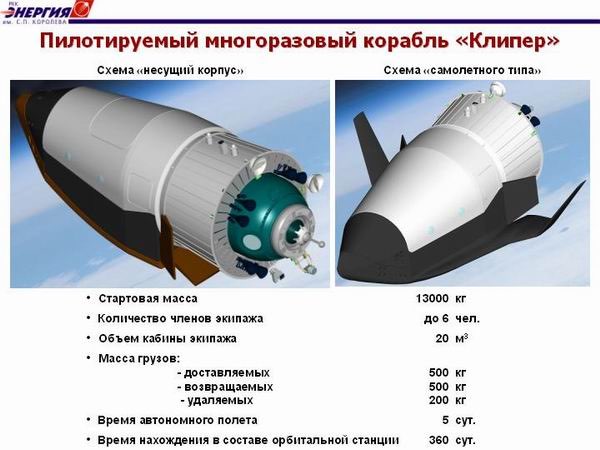 The Kliper spacecraft (lifting body and winged versions). (credit: RKK Energia) |
In the summer of 2006 the Russian space agency unexpectedly canceled a tender to develop the new spacecraft, claiming none of the submitted proposals had fully met its requirements. Instead, the Russians embarked on a collaborative venture with the European Space Agency to explore an Advanced Crew Transportation System that could be adapted for missions to ISS and the Moon. ESA had agreed to such cooperation after receiving clear signs that it was not going to be invited by NASA to help build the Crew Exploration Vehicle for the Constellation program. Although the Moon had not yet been declared an official goal for Russia’s human space program, the Russians had clearly set their sights on a multipurpose vehicle that could eventually be modified for lunar missions, possibly in response to Constellation.
In April 2008, after studying several designs (including a lunar version of Soyuz), the Russians and Europeans settled on a vehicle with a conical Apollo-type return capsule. ESA’s contribution would be a service module using elements of its ATV cargo ship. However, ESA’s participation in the venture was not long-lived. In November 2008, the agency withdrew from the project, citing differences among the agency’s member states and disagreements with the Russians over the missions that would be flown by the vehicle. Just over four years later, NASA, building a new exploration program on the vestiges of Constellation, did ultimately take the Europeans on board to construct a service module for Orion not unlike the one ESA had intended to supply to the Russians.
| Despite the significant budget cuts in FSP 2016–2025, the first flight, an uncrewed solo mission in Earth orbit, remains scheduled for late 2021. |
All this left the Russians with no choice but to announce a new tender for an all-Russian vehicle to replace Soyuz. Facing competition from a rival design by Khrunichev, RKK Energia won the tender in April 2009, having proposed essentially the same vehicle it had been working on with the Europeans, except that the European service module would be replaced by a Russian one. RKK Energia was initially ordered to focus on two Earth orbital versions of the vehicle, one for space station ferry missions and the other for solo missions in Earth orbit. The latter version had an additional pressurized section on top of the re-entry capsule and was seen as a back-up option to conduct research in Earth orbit in case the follow-on Russian space station was canceled. It was not until February 2012, a couple of months after Vladimir Popovkin had declared the Moon as Russia’s new goal in space, that Roscosmos instructed RKK Energia to modify the spacecraft for missions to cislunar space, including the Lagrange points. At the same time, it must retain the capability of servicing Earth-orbiting space stations.
Originally referred to rather prosaically as the Next-Generation Piloted Ship (PTK NP), the spacecraft was named Federatsia (“Federation”) in January 2016 after a public contest organized by Roscosmos and RKK Energia (the runners-up having been “Gagarin” and “Vektor”). Similar in concept to Orion, Federatsia can carry a crew of four and operate autonomously for up to 30 days. In case of an emergency, it has the capability of returning six crew members from the ISS. The deep-space version of the spacecraft weighs six tons more than the space station ferry version (20 tons versus 14 tons), a difference mainly dictated by the larger amount of propellant needed to break out of lunar orbit. Even though the two versions are significantly different, Russian officials have not indicated whether Federatsia is supposed to fly more Earth-orbital missions than the three currently planned as part of its flight test program.
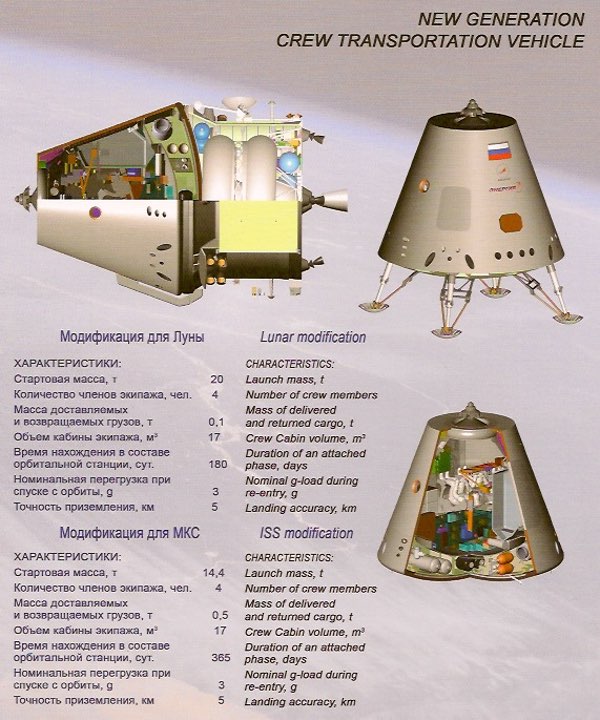 The Federatsia spacecraft. (credit: RKK Energia) |
Federatsia will be launched from Vostochny, the new cosmodrome in Russia’s Far East. Since most of the ascent trajectory takes the vehicle over the Pacific Ocean, a fleet of ships and aircraft will have to be deployed to come to the crew’s rescue in a case of a launch vehicle failure. The problem has been somewhat alleviated by giving the ship’s own engines the capability to place itself into orbit if the rocket suffers a malfunction in the later stages of ascent. Federatsia will use a combination of parachutes and solid-fuel braking engines to land back on Earth. The spacecraft will gently touch down on a set of landing legs, which, along with replaceable heat shield panels, should make it possible to reuse it up to ten times. Landing accuracy will be about five kilometers, six times better than Soyuz. This means the vehicle will no longer have to land in the vast steppes of Kazakhstan. Still, original plans to bring back the spacecraft near Vostochny were dropped when the requirement to return it from a polar lunar orbit necessitated the selection of landing sites in the Orenburg and Saratov regions, not far from the Russian-Kazakh border. Although these sites are on Russian territory, they are thousands of kilometers from Vostochny.
Federatsia has gone through the three development stages that precede the construction of test and flight hardware. That phase was expected to begin last summer, but RKK Energia has so far remained tight-lipped about the test schedule. The only hardware shown so far have been full-scale mock-ups displayed at the biannual MAKS aerospace shows near Moscow, one of which is being used for ergonomic studies. Despite the significant budget cuts in FSP 2016–2025, the first flight, an uncrewed solo mission in Earth orbit, remains scheduled for late 2021. Recent reports have said one of the seats on this and follow-on missions may be occupied by a humanoid robot nicknamed Fyodor, who will be programmed to do simple tasks on board. The initial flight should be followed by uncrewed and crewed missions to ISS in early and late 2023 respectively. Already years behind schedule, Federatsia may not make even these distant target dates. The biggest stumbling block may ultimately prove to be not the spacecraft itself, but the rockets and infrastructure needed to send it into space.
page 2: rocket conundrum >>
|
|